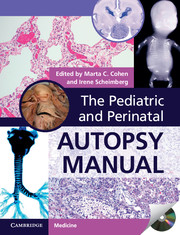Book contents
- Frontmatter
- Contents
- List of contributors
- Foreword
- Preface
- Acknowledgments
- 1 Perinatal autopsy, techniques, and classifications
- 2 Placental examination
- 3 The fetus less than 15 weeks gestation
- 4 Stillbirth and intrauterine growth restriction
- 5 Hydrops fetalis
- 6 Pathology of twinning and higher multiple pregnancy
- 7 Is this a syndrome? Patterns in genetic conditions
- 8 The metabolic disease autopsy
- 9 The abnormal heart
- 10 Central nervous system
- 11 Significant congenital abnormalities of the respiratory, digestive, and renal systems
- 12 Skeletal dysplasias
- 13 Congenital tumors
- 14 Complications of prematurity
- 15 Intrapartum and neonatal death
- 16 Sudden unexpected death in infancy
- 17 Infections and malnutrition
- 18 Role of MRI and radiology in post mortems
- 19 The forensic post mortem
- 20 Appendix tables
- Index
- References
7 - Is this a syndrome? Patterns in genetic conditions
Published online by Cambridge University Press: 05 September 2014
- Frontmatter
- Contents
- List of contributors
- Foreword
- Preface
- Acknowledgments
- 1 Perinatal autopsy, techniques, and classifications
- 2 Placental examination
- 3 The fetus less than 15 weeks gestation
- 4 Stillbirth and intrauterine growth restriction
- 5 Hydrops fetalis
- 6 Pathology of twinning and higher multiple pregnancy
- 7 Is this a syndrome? Patterns in genetic conditions
- 8 The metabolic disease autopsy
- 9 The abnormal heart
- 10 Central nervous system
- 11 Significant congenital abnormalities of the respiratory, digestive, and renal systems
- 12 Skeletal dysplasias
- 13 Congenital tumors
- 14 Complications of prematurity
- 15 Intrapartum and neonatal death
- 16 Sudden unexpected death in infancy
- 17 Infections and malnutrition
- 18 Role of MRI and radiology in post mortems
- 19 The forensic post mortem
- 20 Appendix tables
- Index
- References
Summary
The important role of a general pathologist performing a post mortem on a baby born with multiple congenital malformations is to identify if there is a recognizable pattern, i.e., syndrome. Precise and comprehensive examination of babies born with multiple malformations is necessary to make an accurate diagnosis, and to provide prognosis and genetic counseling for parents. The set-up in different centers may vary, but this chapter provides a general approach to pattern recognition illustrated by common examples seen in clinical practice and use of further genetic resources to aid in this approach.
Fetal loss can occur due to a variety of causes and may be spontaneous or induced following findings of an anomaly on a scan. One of the foremost concerns is recurrence in a future pregnancy. Studies have shown wide discrepancies in the referral patterns in genetic centers throughout the world [1,2]. In addition to this, there are also differences of opinion as to what pathology is significant enough to warrant referral to clinical genetics, i.e., should isolated anomalies like polydactyly be referred? In cardiac pathology, should isolated cardiac anomalies be referred so as to consider the possibility of an underlying “syndromic” diagnosis? This chapter provides an overview of different pathology encountered in post mortem examination with common syndromal associations.
Introduction
Dysmorphology is the term used to describe the recognition and study of birth defects and syndromes. It was first used by David Smith in 1960 to describe the study of patterns of malformation, resulting in accumulation of knowledge regarding defects in morphogenesis [3]. This has helped understand structural development in humans.
Syndrome is a recognizable and consistent pattern of developmental anomalies, occurring often together and known or assumed to be due to a single etiology. The word is derived from Greek, meaning “running together.” In clinical practice, an individual may be considered syndromal if they have more than one clinically recognizable feature occurring together more often than by chance. Pattern recognition is important in making a syndromal diagnosis; features in a particular syndrome are often seen together. For example, in trisomy 21 (Down’s syndrome), there is distinctive facial dysmorphism, cardiac defects, wide sandal gap, and single palmar crease, which are often seen together. Many of these features may be seen in the general population and are often considered to be normal variants.
- Type
- Chapter
- Information
- The Pediatric and Perinatal Autopsy Manual , pp. 105 - 119Publisher: Cambridge University PressPrint publication year: 2000



